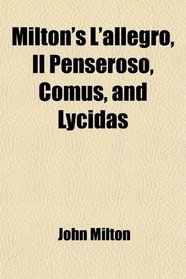Search -
Milton's L'allegro, Il Penseroso, Comus, and Lycidas
Milton's L'allegro Il Penseroso Comus and Lycidas
Author:
Purchase of this book includes free trial access to www.million-books.com where you can read more than a million books for free. This is an OCR edition with typos. Excerpt from book: NOTES. L'ALLEGRO. L'Allegro and II Penseroso, owing to their close relation in form and matter, should be read together. Although they were not printed unt... more »
Author:
Purchase of this book includes free trial access to www.million-books.com where you can read more than a million books for free. This is an OCR edition with typos. Excerpt from book: NOTES. L'ALLEGRO. L'Allegro and II Penseroso, owing to their close relation in form and matter, should be read together. Although they were not printed unt... more »
ISBN-13: 9780217237826
ISBN-10: 0217237827
Publication Date: 8/9/2009
Pages: 124
Rating: ?
ISBN-10: 0217237827
Publication Date: 8/9/2009
Pages: 124
Rating: ?
0 stars, based on 0 rating




